Plasterers
Plastering and Skimming Services
Plasterers: Undertaking home improvements or refurbishments in the UK often involves dealing with plaster walls – either repairing existing ones or applying new plaster. Plastering is a highly skilled trade and, unless you're exceptionally confident in your DIY skills, it's not advisable to attempt it yourself. This is especially true for plastering ceilings, as it can easily lead to both your home and yourself getting messy. Hiring a professional plasterer is a wise decision for such tasks. Although finding a plasterer in the UK shouldn't be difficult, securing one with availability to suit your schedule can be more challenging. Plasterers, like many skilled tradespeople, are in high demand. Therefore, it's best to plan ahead and book a plasterer several weeks in advance to ensure they're available when needed.
There are a lot of home improvement tasks, even modest ones, which result in some plastering work having to be done. It might be things such as skimming a partition, plaster repair to get ready for tiling, fitting mouldings or coving before decorating or plastering over artex. In fact, it might possibly be any one of a host of plastering related chores.
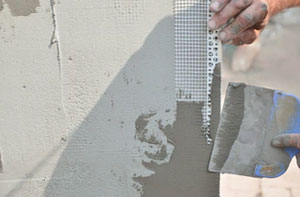
Ask potential UK plasterers if they've got a portfolio of successfully completed work, the most important thing is to hire a plasterer who knows what they are doing. This is not the sort of work you want to be giving to "cowboys". You may encounter major complications later on when the caliber of the plastering is poor, and these aren't always immediately noticeable.
When your freshly plastered wall is given a splash of emulsion, any imperfections will soon become noticeable. When viewed in bright sunshine, even more imperfections will show up on any uneven surfaces. By selecting only from experienced plasterers in the UK, you can avoid such issues.
Plastering has to be level and smooth, since it's just a base on which other materials and products are placed. It is very simple to fill and smooth off any slight cracking and dents, but it's tricky to hide fundamentally irregular surfaces. Areas that are irregularly plastered can cause trouble with kitchen or bathroom tiling, the fitting of skirtings, the wallpapering and painting of ceilings and walls and the installation of kitchen units.
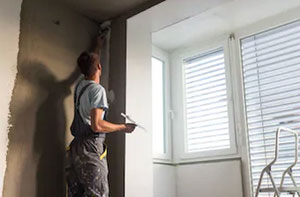
The most sought after UK plasterers will get a perfect finish straight from the trowel. A brief rub down before decorating is the most that a plastered ceiling or wall should need, it should never need to be sanded. You would be correct in thinking that the plastering has not been done to a satisfactory level if extensive sanding is required. If the use of electric sanders is becoming commonplace, there's definately something is amiss with your plasterer.
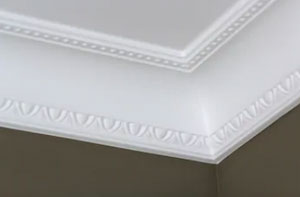
One of the most regular tasks for plasterers in recent times, is plastering over old artex ceilings. At present out of favour in the UK, artex was the most popular decorative finish for ceilings during the seventies and eighties. Plastering over that dated artex ceiling to make it look more sleek and modern is something that most plasterers in the UK will jump at the chance to do. If however, you want to bring a bit of that old style back into your home, most plasterers will be just as glad to apply artex as they are to plaster over it.
Do-it-Yourself Plastering UK: Although when you have plastering work which needs to be done in your home in the UK, it is better to employ an experienced plasterer to handle it, it's still quite possible to have a bash yourself, if you have the confidence and are reasonable at DIY. Practicing on an area that already has a poor quality plastered finish is a wise idea to begin with, so your novice plastering amateurish efforts are unlikely to make it any worse. An out-of-sight area or a spare bedroom would be a good start. This is likely to be much less stressful for you, and enable you to spend a bit of time mastering your newly found skills. It's quite possible to re-skim a wall as many times as you wish to a certain degree, and you can easily re-do it if you do not do a decent job the first time around.
Now, you may have navigated to this page in search of "plastering services UK", not due to the fact that you reside in UK itself, but in one of the surrounding areas like Belfast, Edinburgh, Scotland, Glasgow, Cardiff, Greater Manchester, Bristol, London, Liverpool, Wales, England, Sheffield, Northern Ireland, Birmingham, Swansea, or someplace similar. But, there's no need to worry given that UK plastering companies routinely work in these locations as well and will generally be happy to offer you such services.
Rendering UK
The process of applying a mixture of lime, sand, cement and water to either interior or exterior walls to achieve a smooth or textured surface finish, is called rendering, which is a very similar technique to plastering. Rendering is really common in the Mediterranean region, but is also extremely popular all around Europe. A rendered surface is mostly employed for cosmetic reasons but is also waterproof and has got some fire resisting properties. You can obtain a longer lasting and more resilient finish by adding colour to the render itself, though of course it is possible to paint a rendered surface.
Screeding
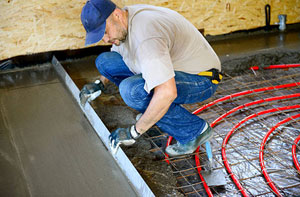
Screeding calls for the spreading of a cement mix, to produce a flat, smooth floor surface. Usually screeding is applied over a concrete sub-floor to be used as a finished hardwearing floor surface, to receive an appropriate floor finish (such as tiles, floor boards or carpet) or to encase underfloor heating pipes. This will help to extend the lifespan of the whole floor and assure its durability, finish and quality, for years to come. Screed is only mixed by hand where relatively small areas of floor are being worked on. For larger projects, a reliable screed pump needs to be used to guarantee an even and smooth blend of sand, cement and water, which is then pumped straight to the required location.
Pebble Dashing
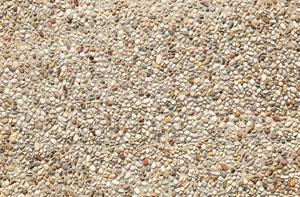
Some people love it and some people hate it but pebble dashing has been around for many years and used to protect and decorate the exteriors of dwellings in the UK. UK plasterers will sometimes carry out this type of project for you, although there are pebbledashing specialists working in the area. Pebble dashing (or pebbledashing) is a form of exterior wall covering which usually consists of a couple of layers of a base made from lime and sand onto which small pebbles, gravel or shells are pressed to create a maintenance free, strong and attractive finish on both renovated and new houses.
Plasterboarding UK (Dry Lining)

Dry lining is quite frequently required in home refurbishment projects, and you will find some plasterers in the UK who provide this particular service. By fixing plasterboard to metal framing, a timber studding or a brick or masonry surface, a smooth, flat wall surface is produced which does not have to be plastered. Sometimes the plasterboard itself is painted, although mostly it will get a fine skimming with a thin layer of finishing plaster, that can be wallpapered or painted without the need for filling. In regards to fittings, when fixing plasterboard to wood joists or studding, drywall screws or nails are used, when attaching to a masonry or brick wall the "dot and dab" method is used and when attaching to a metal framework self-drilling, self tapping (Jack-Point screws) are used.
Plaster UK

Used for decorating and protecting walls and ceilings in buildings, plaster is a material which has been used since the days of the ancient Egyptians. In the United Kingdom the term "plaster" usually pertains to a material that's used on the interior of houses, whilst the material used on exterior surfaces is called "render". The plaster blend itself can include different ingredients but most commonly consist of either gypsum, cement, or lime. All of these mixtures work in pretty much the same way, but serve different purposes. Plaster is is produced in powdered form and when required, is simply mixed with water to produce a stiff but easily workable paste immediately prior to application. A chemical reaction is caused when the water and plaster are combined together, and hardening occurs as a result of the heat produced through a process called crystallization.
Artexing UK

Even though artex isn't as popular today as it was in the 1970's and 1980's it is still an easy way to enhance the look of a cracked or uneven ceiling. Back in the day, there were such a lot of tradespeople doing artexing it was pretty easy to find someone providing this service in the UK. These days however, finding a plasterer who does artexing is not quite as straightforward. Doubtless the huge variety of designs and styles was just what made it so widely loved, and everybody appeared to have their particular favourite, be it scroll, circle, criss-cross, medusa, bark, stipple, basket weave, pairs, broken leather, hook & line or swirl. Patterns of artex were available to suit any taste or personal preference. All of these artex patterns can still be carried out today if you are able to track down a local plumber or artexer prepared to do it. Avoid "handyman" types who offer to "have a bash". Having said that, it should be mentioned that artex is rather difficult to repair or patch and it's almost certainly because of this that its use declined. (Tags: Artex UK, Artex Removal UK, Artex Repairs UK, Artex Patching UK, Artexing UK)
Decorative Plastering UK
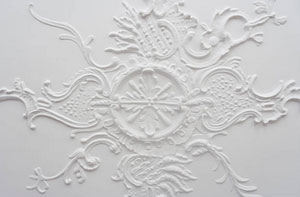
Plaster has been practiced for both functional and decorative objectives ever since the days of the ancient Egyptian builders. The materials used would naturally have been different in those long forgotten days, when combinations of both clay and mud would have been employed. A type of plaster was applied to the walls of structures in 13th century London to help prevent fires from spreading. During the Victorian and Georgian periods huge advances occurred to develop decorative features and mouldings out of plaster of Paris, as you'll witness if you visit buildings of this time. Talented plasterers working today are able to produce breathtaking decorative effects by combining modern day materials with centuries old techniques. Such decoration take many shapes and may involve the use of cornices, ceiling roses, dentils, corbels, brackets, niches and coving. (Tags: Plastering Effects UK, Plastering Finishes UK, Plaster Mouldings UK, Decorative Plastering UK)
Skimming UK

Plaster skimming is a great way to give walls and ceilings a smooth, flawless finish, ready for decorating. Whether you’re refreshing an older property or tackling a new build, skimming creates a clean surface, ideal for painting or wallpapering. It’s particularly useful for covering minor imperfections, like cracks or dents, or for updating outdated textured finishes. The process involves applying a thin layer of plaster over existing surfaces, which requires a steady hand and a good level of expertise to get that perfectly even result. A professional plasterer will ensure a high-quality finish, saving you time and effort while delivering a surface that looks pristine. With the right touch, plaster skimming can completely transform a room, giving it a polished, modern look.
Plaster Patching UK
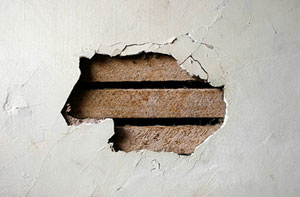
If you own an older property, or have recently had a bit of construction work carried out on your home in the UK, it's fairly possible that you may have damaged or cracked plasterwork that needs patching or replacing. So it can be effectively decorated and kept nice, your plaster ought to be kept in good condition at all times. Cracked or crumbling areas of plaster and patches which have been poorly fixed with Polyfilla, look awful and ruin the overall appearance your property. A professional UK plasterer will pretty quickly have your walls looking great once again, and you'll be able to conclude your painting and decorating and have them looking in pristine condition once again. Your plaster walls can be impacted by a lot of different issues, with dampness, accidental damage, settlement, vibration and shrinking being some of the more commonplace causes. When there's an underlying situation, you'll have to address that before doing any patching up, or else the issue will likely recur. (Tags: Plaster Repairs UK, Patching Plaster, Plastering Repair UK, Plaster Patching UK, Patch Plastering UK)
Polished Plaster UK
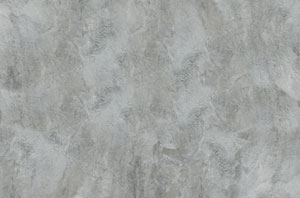
Polished plaster is largely the definition given to up-to-date variants of traditional Italian plaster finishes which have been used to good effect throughout the centuries. Describing anything from more rugged looking textured plasters to highly polished Lucidato, Venetian and Marmorino plasters, the phrase "Polished Plaster" in fact covers a number of top quality plaster finishes. Offering a finish that looks just like marble, limestone or travertine, polished plaster is normally used on inside walls and ceilings. Polished plaster has got natural shade variations delivering a feeling of depth while still smooth to the touch. Original bespoke finishes can be achieved by blending these various sorts of plasters. Through the use of natural or synthetic colourants, appealing tints or colours can be applied to the polished plaster finish. If you wish to achieve a "marbled" effect in your plaster, or bespoke designs or colours that don't exist in nature, the capability to add a tint to Venetian plaster is particularly helpful.
Plastering Courses UK

If you'd like to start a career in the plastering trade or maybe desire to have some basic skills in plastering you should have a look at taking a plastering course of some kind. For people wanting to better their plastering skills and for newbies, there are a multitude of plastering related courses on offer. There are advanced and beginner plastering courses available in either NVQ or City and Guilds. Beginners courses in plastering (level 1) tackle things such as making ready background surfaces, applying scratch coats, putting on set coats (walls), applying floating coats (walls), fixing sheet materials and mixing plaster materials. Intermediate and advanced (level 2 courses and diplomas) tackle things such as dry lining/plasterboarding, fibrous plastering, plastering to external surfaces, reverse moulds for fibrous plasterwork and cement and sand screeding. For currently available plastering courses in the UK and throughout UK, try searching on Google. It is possible to book intensive 5 day plastering courses HERE. (Tags: Plastering Lessons UK, Plasterers Courses UK, Beginners Plastering UK, Plastering Courses UK)
UK plastering specialists will likely help with Marmorino plastering, fibrous plastering UK, lay in grid suspended ceilings, stucco plaster UK, floor screeding and bull floating in the UK, concrete plastering, lime plastering, float and set plastering, pebble dash restoration, tyrolean rendering, ceiling replacements, rendering with sand and cement, metal studding partitions UK, damaged plaster renovation in the UK, drywall taping, ceramic tiling in the UK, asbestos testing, coloured K Rend, artexing ceilings and walls, plastering over artex, false ceilings, artex broken leather patterns, repairing holes in walls and ceilings, dragged plaster UK, magnetic plaster UK, wet dashing, dry lining and plastering walls UK, ceiling overboarding, ceiling crack repairs, cellar plastering, polished plastering and other plastering work in the UK.
UK Plastering Services
- UK Artex Covering
- UK Plasterers
- UK Plastering
- UK Plaster Patching
- UK Cornice Installation
- UK Floor Screeding
- UK Coving Installation
- UK Commercial Plastering
- UK Domestic Plastering
- UK Float and Set
- UK Plaster Repairs
- UK Plasterer
- UK Polished Plaster
- UK Soundproofing
 Plasterers UK
Plasterers UK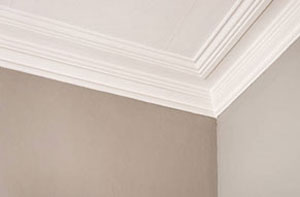 Plastering Near Me
Plastering Near Me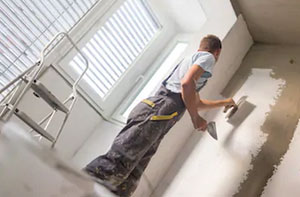 Plasterer UK
Plasterer UKMore UK plasterers: Cheap Plastering, Cheap Plastering, Plaster Repair, Plaster Skimming, Patch Plastering, Plaster Repair, Plaster Repairs, Internal Plastering, Plastering Repair, Plasterer, Plaster Repairs, Pebble Dashing, Domestic Plastering, Plastering Contractors, Plastering, Cheap Plastering, Plastering Firms, Plaster Repairs, Plasterers, Cheap Plastering, Plastering Services, Plastering Firms, Cheap Plastering, Plaster Skimming, Plastering Repairs, Internal Plastering, Plasterers, Plasterer, Plaster Repairs, Plastering Firms, Plastering Repair, Plasterer, Plaster Patching, Plaster Patching, Plastering Services, Plastering Firms, Cheap Plasterers, Plaster Repairs, Domestic Plastering, Plastering Companies, Plastering Repair, Plastering Repair, Pebble Dashing, Plasterers, Plaster Skimming, Plastering Firms, Plaster Skimming, Pebble Dashing, Plastering Repair, Residential Plastering, Patch Plastering, Plasterers, Plaster Repair, Patch Plastering, Cheap Plastering, Plasterer, Cheap Plasterers, Domestic Plastering, Plaster Repairs, Plastering, Plastering Contractors, Plastering Repairs, Domestic Plastering, Plaster Skimming, Plasterers, Plastering Repairs, Plastering Repair, Plasterer, Commercial Plastering, Plastering Repairs, Plastering Specialists, Commercial Plastering, Residential Plastering, Plastering Repairs, Plasterers, Plastering Services, Residential Plastering, Plasterer, Plaster Repairs, Plastering Firms, Plastering Repair, Commercial Plastering, Plastering Companies, Commercial Plastering, Plastering Repairs, Plastering Repair, Plastering Services, Cheap Plastering, Plastering Repair, Plastering Repair, Patch Plastering, Patch Plastering, Plaster Repairs, Plastering Services, Commercial Plastering, Plaster Skimming, Commercial Plastering, Internal Plastering, Plastering Companies, Plastering Repairs, Cheap Plastering, Plastering Companies, Pebble Dashing, Plastering Contractors, Plaster Skimming, Plaster Skimming, Pebble Dashing, Plaster Repairs, Pebble Dashing, Plaster Patching, Plastering, Plastering Repairs, Plaster Skimming, Plastering Contractors, Internal Plastering, Plastering Services, Plastering Companies, Plastering Services, Plastering Specialists, Cheap Plastering, Plastering Contractors, Plasterers.
Plasterers in the UK area.





